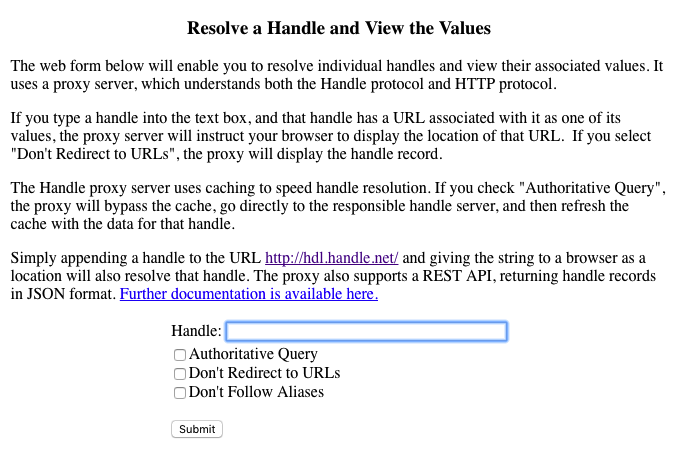About
Documentation about the usage of the EUDAT service B2HANDLE.
Modified: 11 June 2019
Synopsis
B2HANDLE is a distributed service, designed to meet the fundamental research data management requirement of data persistency by maintaining opaque, globally unique persistent identifiers (PIDs). B2HANDLE enables EUDAT services and user communities to assign such persistent identifiers to different kinds of managed objects, based on the Handle System. Handle is a reliable, redundant and scalable system built on an open architecture and designed to allow end-users to manage PIDs with ease. The B2HANDLE service encompasses management of identifier namespaces (handle prefixes), establishment of policies and business workflows, operation of Handle servers and technical services, and a user-friendly Python library for general interaction with Handle servers and EUDAT-specific extensions.
This document discusses how end-users with access to a B2HANDLE instance can use the service to resolve handles.
What is B2HANDLE?
B2HANDLE is EUDAT's main Persistent Identifier service. B2HANDLE is a distributed service, designed to contribute to data persistency by maintaining opaque, globally unique persistent identifiers (PIDs). PIDs are used to reliably identify and cite data objects throughout their lifecycle and they are thus a vital part of long-term data management. Moreover, data can be directly retrieved by means of PIDs, and corresponding key metadata can be stored together with them in the so-called PID entry. The B2HANDLE service encompasses management of identifier namespaces (Handle prefixes), establishment of policies and business workflows, operation of Handle servers and technical services, and a user-friendly Python library for general interaction with Handle servers and EUDAT-specific extensions.
B2HANDLE service resolution is also based on the Handle System, which offers a very reliable resolution service. B2HANDLE forwards the user to the current location of the object. The B2HANDLE Python library is a client library for interaction with a Handle System server, using the native REST interface introduced in Handle System 8.
In the EUDAT ecosystem EUDAT services make use of B2HANDLE to guarantee data access, long lasting references to data and to facilitate data publishing. B2SAFE and B2SHARE use the service to create and manage PIDs for their hosted data objects, whereas B2FIND and B2STAGE use the resolving mechanism of B2HANDLE to retrieve and refer to objects.
Persistent identifiers
In order to access a data object stored in EUDAT, an associated persistent identifier (PID) is needed. B2HANDLE enables EUDAT services and user communities to assign PIDs to different kinds of managed objects stored in the EUDAT CDI. The underlying technology is based on the Handle System, which is a reliable, redundant and scalable system built on an open architecture and which is mostly transparent to the end-user, hiding from them the complexity of infrastructure details.
The goal of persistent identifiers is to provide long-term stable references for digital objects that enable retrieval of an object and corresponding key metadata (so-called PID records) over at least the lifetime of the object and in the face of changes in object location or ownership. The persistent identifiers used in EUDAT are handles, which take the form “<prefix>/<suffix>”. A handle name is thus first and foremost a name formed according to this syntax and without particular meaning; to properly use it for object identification, each handle name has to be explicitly registered at a Handle server. Each Handle server is responsible for a number of prefixes, but unlike URLs, these prefixes cannot be freely chosen. A prefix, or Handle namespace, has to be acquired first through specific authorities.
How can I benefit from B2HANDLE?
End-users of the EUDAT services that are integrated with B2HANDLE can benefit from the long-term stable references to digital objects, both during the objects' lifetime and beyond. The policies and workflows B2HANDLE creates and maintains increase trust in persistent identifiers, improve interoperability and facilitate efficient and effective operations.
How can I use B2HANDLE?
As an end-user, you can resolve handles through the Handle System’s baseline services.
Resolve Handle through the Resolution Service.
An end-user knows only the PID of an object (ex. 11111/MYHANDLE). The user may use it to reference the object, but they may also use it to get the location of the object or some extra metadata. In order to do that the user may visit http://handle.net/ and use the Resolution Service. The Resolution Service forwards the user to the current location of the object, or gets the details of the PID, as shown on Figure 1 below: if the user just types the handle, they will be redirected to the current location of the object; if the user selects "Don't Redirect to URLs", the service will display the handle record (the details of the PID).
Figure 1: The Handle system resolution service user interface.
Resolve PIDs
An end-user knows only the PID of an object (ex. 11111/MYHANDLE). Instead of just using the PID when an end-user is referencing an object, they may use what is known as an "actionable PID": simply appending a handle to the URL of a resolver, like http://hdl.handle.net/, and giving the string to a browser as a location will also resolve that handle, e.g. http://hdl.handle.net/11111/MYHANDLE. Other users may cite, access, re-use this URL and they will always be redirected to the location of the object.
Support
You can access B2HANDLE hands-on training material from our github; note in particular the session dedicated to using B2HANDLE.
Support for B2HANDLE is available via the EUDAT ticketing system through the webform.
If you have comments on this page, please submit them though the EUDAT ticketing system.
Document Data
DocVersion: 1.1.1
Authors:
Tobias Weigel, weigel@dkrz.de
Themis Zamani, themis@grnet.gr
Editors:
Christine Staiger, christine.staiger@surfsara.nl
Kostas Kavoussanakis, kavousan@epcc.ed.ac.uk

